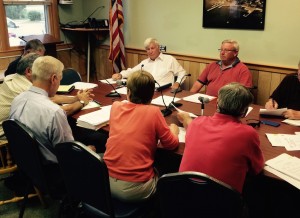Charged with helping the town find a way to improve its harbor plan, David Janik, South Coast regional coordinator for the Massachusetts Coastal Zone Management Office (CZM), a branch of the Executive Office of Energy and Environmental Affairs, met with the Mattapoisett Marine Advisory Board on June 25. The MAB over the years has aided in crafting waterside rules and regulations for boating. Several years ago they developed a harbor management plan, but that document did not protect the town against proposed construction of private docks and piers.
Town Administrator Michael Gagne was directed by the Board of Selectmen to bring some clarity and strength to the existing harbor management plan on the heels of an appeal to the Massachusetts Department of Environmental Protection for the construction of a large private pier that extends into the harbor – an area designated for recreation by the MAB via the harbor management plan. The appeal is currently being reviewed by the DEP after lengthy public hearings.
Over the past months, the pier application has navigated through various town boards and subsequently appealed at the state level. The town’s harbor management plan seemed too weak to be of meaningful use in upholding the town’s assertion that the pier location would be a detriment to public access and rights.
“The selectmen are concerned our plan didn’t have the strength or clout we needed,” Gagne told the board members, adding, “…We need a plan with some substance and teeth.”
Janik then described the plan development process.
For a state approved plan, Janik said, “The state has a detailed process that is time consuming and expensive.” He pointed to the harbor management plan created by New Bedford and Fairhaven several years ago, saying that it cost them approximately $200,000, primarily in consultant fees. He said that consultants are generally used to help cities and towns create a document that would be acceptable for state certification. But he questioned if Mattapoisett really needed something that complex.
For a plan to receive state approval, Janik said that first the town needed to identify “the suite of issues you want to address.” He then said that a proposal is sent to the CZM and, if it meets all the requirements, it would receive approval to proceed.
He again asserted that for plans heading towards state certification, consultants who specialize in this area must be used. However, even after expending time and money, some plans may still not achieve certification, Janik warned.
When asked what the advantages and disadvantages are to developing a state certified plan, Janik responded, “The ability to change a significant number of Chapter 91 requirements…. Things can be manipulated and adjusted through the tool of a state certified plan.” Massachusetts General Law Chapter 91 regulates many aspects of water-related activities, including construction of docks and piers.
As for disadvantages, Janik pointed to the time, effort, and costs associated with the process. But again, he questioned if Mattapoisett even needed a certified harbor management plan.
“New Bedford’s Chapter 91 area extends inland,” Janik explained, as Chapter 91 jurisdictional area goes to historic high tide lines. In the case of New Bedford, the harbor line has changed significantly over decades of use and has been filled in to create landmass. He said that Mattapoisett’s coastline has basically not changed or been filled.
Board member Patricia Apperson asked, “So what are the advantages?”
“Probably very little,” Janik replied.
Gagne asked what the town should do to improve the language in the existing document so that it would be viewed as meaningful to the DEP in the future.
Janik said the language in the plan needed to be very specific and not vague, such as simply stating an area should be reserved for “recreational use.” He said piers and docks were not viewed as encumbrances to such activities.
“If you go through a reasonable process to show the DEP where you don’t want docks and piers,” said Janik, “you show your reasoning on it such as the past, present, or future presence of eelgrass, shell fishing beds, endangered species, for these reasons, these sensitive areas … no more docks and piers.” Janik said such language is stronger and therefore has more meaning to the DEP.
According to Janik, public hearings showing public involvement should also be produced to demonstrate resident involvement. Janik told the MAB that a strongly worded letter from the selectmen should accompany the harbor management plan, even if the plan itself is not state certified. The combination of the two documents carried weight with the DEP, he said.
“You must show a process and fairness,” Janik emphasized. He said this process with the letter from local governing bodies is “a tool that very few communities know about or have used.”
Janik also said aesthetics – a desire by the town to keep certain coastlines clear of private docks and piers – can be part of a harbor management plan.
Gagne said, “So we don’t have a problem down the road if we need to perfect this.”
Janik offered his assistance moving forward. The MAB will review the harbor plans from Harwich, Chatham, Marion, and the state certified plan from New Bedford/Fairhaven as they work towards improving the language in Mattapoisett’s harbor plan.
The next meeting of the Mattapoisett Marine Advisory Board is scheduled for July 30 at 7:00 pm in the Mattapoisett Town Hall conference room.
By Marilou Newell
